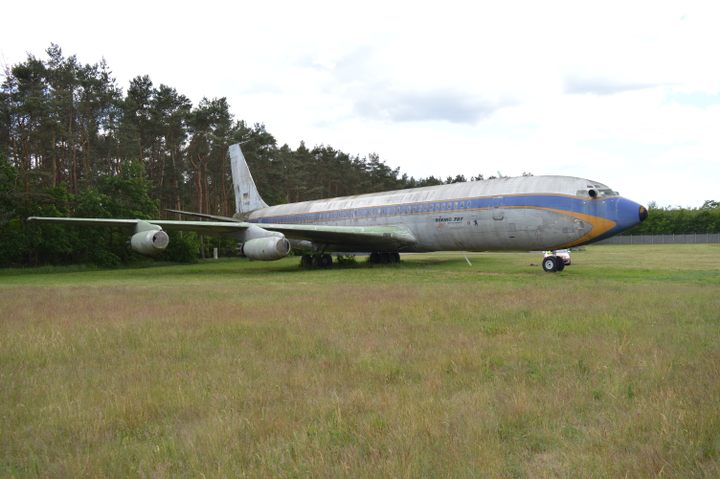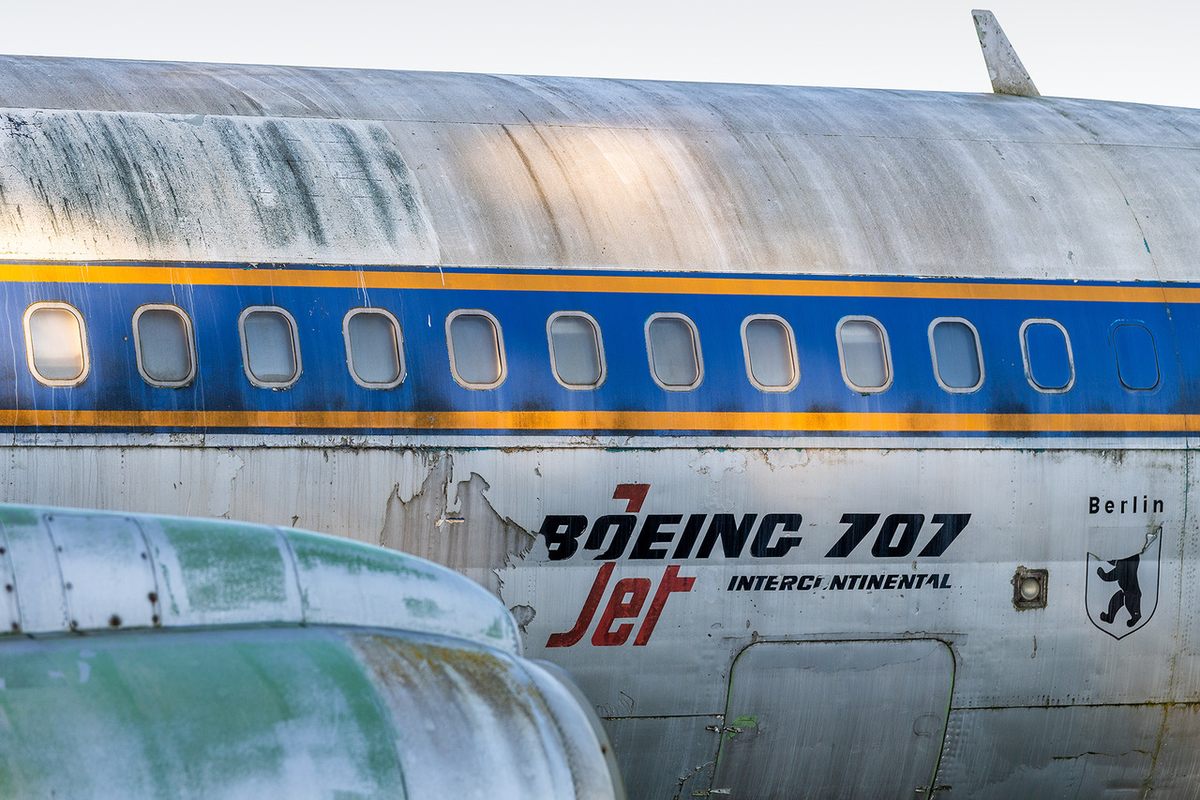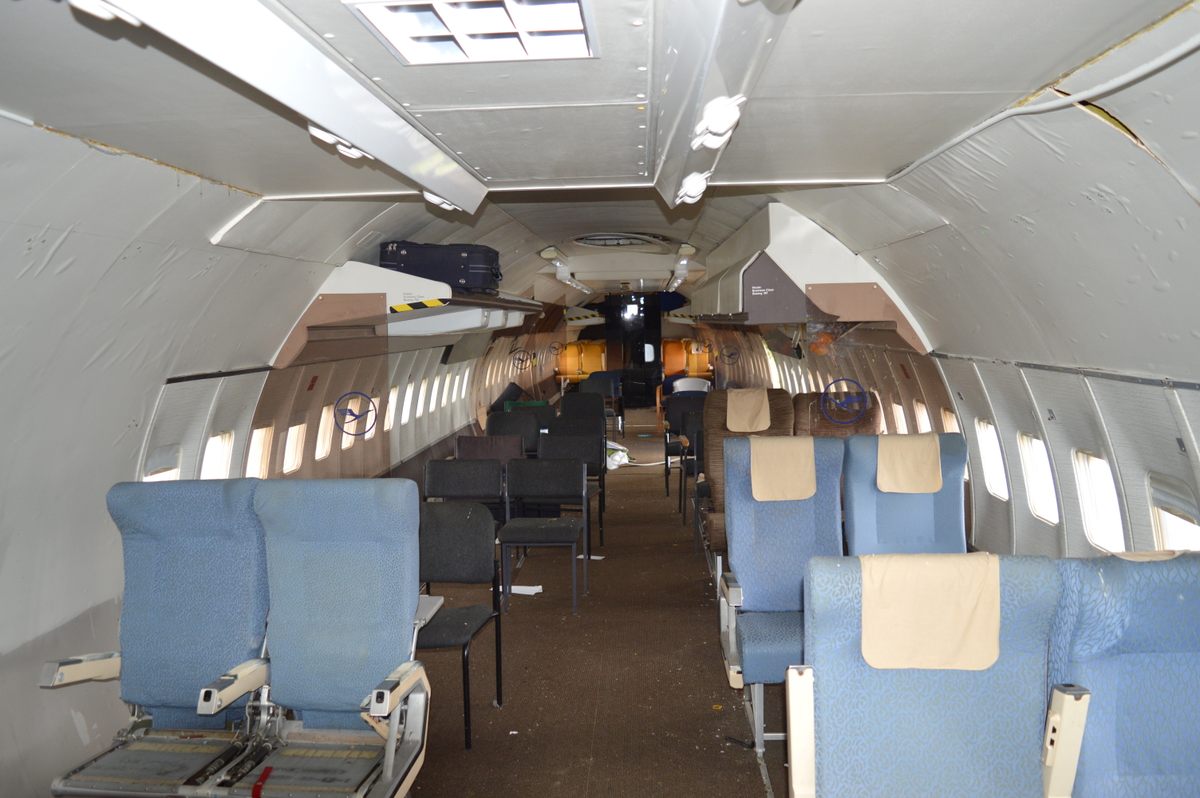
The Last Plane at Tegel Airport Has Survived Hijackers and Cold War
Parked far from the runway, the dilapidated 707 is an artifact of Berlin’s divided past.
On September 6, 1970, four flights heading from Europe to New York were hijacked in a coordinated action by members of the Popular Front for the Liberation of Palestine (PLFP). Two of the aircraft wound up landing in Jordan on a desert airstrip called Dawson’s Field. Another was diverted to Cairo. Intense hostage negotiations followed.
The pilot of the fourth plane, El Al Flight 219, managed to subdue the two hijackers on board by sending the aircraft into a nosedive 20 minutes after taking off from Amsterdam. One of the hijackers, Nicaraguan-American Sandinista Patrick Argüello, was shot and killed by an air marshal. The second, Leila Khaled, who had already hijacked TWA Flight 840 a year earlier, was overpowered and arrested. During the attack, Argüello critically injured flight attendant Shlomo Vidor. Seeking speedy medical attention for the injured attendant, pilot Uri Bar-Lev disregarded instructions to re-route to Tel Aviv and landed safely in London.

The Boeing 707 from that fateful flight is today parked in the far southwest corner of Berlin’s recently shuttered Tegel “Otto Lilienthal” Airport. One of the plane’s passenger doors hangs off its hinges. Two sets of boarding stairs in similarly bad shape are lined up neatly adjacent to the aircraft. Mold grows over its mid-century livery, which marks the plane as a Lufthansa 707, not El Al. This curious tableau is clearly visible from the other side of the razor wire-topped fence separating the end of the airport from a trail at the edge of the Jungfernheide forest. The plane is historic for several reasons, but its days are numbered.

After the foiled attack, and prior to winding up in the Deutsches Technikmuseum’s possession, the plane returned to normal operation. At the time, hijackings were much more common than they are now—between 1968 and 1972, there were 326 attempted hijackings worldwide. The aircraft remained part of the fleet until April 1984, when it was leased to another Israeli airline, Arkia, until July 1986. Then it was sold back to Boeing in September of that year. “From what I understand,” emails Stanley Morais, El Al’s acting director of international affairs, “Boeing gave it to Lufthansa as a gift celebrating 30 years of working together (in a sort of retro livery) and Lufthansa gifted it to the aviation museum in Berlin.”
Heiko Triesch, the aerospace curator at the Deutsches Technikmuseum (German Museum of Technology), says Boeing gave the former El Al 707 to Lufthansa so the German airline could use it as a prop in honoring the company’s 1926 Berlin origins. “Lufthansa wanted to place a symbol somewhere that they were both interested in Berlin and founded there,” Triesch explains. During the Cold War, Lufthansa was barred from operating in the city of its founding. Because West Berlin was entirely surrounded by East Germany, the city’s three airports, Tegel, Tempelhof, and Gatow, were connected to the rest of the West only by strictly controlled air corridors. French, British, and American airlines were the only commercial operators allowed to fly in or out.

Upon receiving this regift from Boeing, Lufthansa Technik repainted the plane in the airline’s post-war livery, then scrupulously covered it up to sneak the craft into West Berlin. American pilots flew the plane to Tegel from Frankfurt undercover in 1987. For years, the Boeing 707 was proudly displayed as a gate guard, “so the first thing you saw when you flew from Berlin was a Lufthansa plane painted in their 1950s design,” Triesch says.
After the Wall came down and Berlin was reunified, the plane, like much of the city’s infrastructure, met with rapid change. Lufthansa could now operate in the city, and a renovation project in front of Tegel meant the Boeing 707 was in the way. Triesch thinks the plane was moved from its plum position to its current area—under a stand of pine trees, far from view of the airport buildings—in the late ‘90s or 2000. The 707 was used for a while as a training site for fire brigades and special police forces, but otherwise, the aircraft has been left to the elements. This despite Triesch mandating that, for the sake of preservation, “you always have to keep an airplane under a roof.” Today, the 707’s exterior draws observers as much for its derelict condition and unlikely parking spot as it does for its out-of-production status and retro paint job.
The Deutsches Technikmuseum owns multiple other historically significant aircraft including a Candy Bomber, one of the iconic Douglas DC-3’s used to parachute little packages of sweets to West Berlin children during the Berlin Air Lift. By comparison, the Boeing 707 is not a particularly high-value museum object. “It was a gift we did not want to get, but eventually, we had to take it,” Triesch says. With the plane no longer certified to fly and the prestige of its former parking spot in front of Tegel wiped away by changing history, the 707 quickly became a hassle nobody has been able or inclined to deal with. Triesch estimated the cost of disassembling and trucking it to the museum’s storage at another former Berlin airport, Tempelhof. That alone would be around 100,000€; adding on a restoration project puts it in the millions. The museum’s contract with Lufthansa stipulates the airline cover certain associated costs, and though they were previously “always generous when we asked them for support, in the current situation, every cent they can save, they’re saving,” Triesch says.

The aircraft’s fate is also contingent on a specter of Berlin’s present-day history: gentrification. The city once known for its creative, counterculture squats loses more of them to developers every year. In October 2020, 1,500 police evicted the 30-year-old queer, anarchofeminist squat Liebig 34 in a widely criticized action that reportedly cost the city at least a million euros. Across town, Berlin’s new airport, BER, opened on October 31 (eight years late and billions of euros over budget). Tegel officially closed eight days later. The former airport is currently slated for redevelopment as a mixed-use residential and commercial project. The airplane is a derelict curiosity, and it has to go. “What we thought was, why not repaint the airplane and keep it at Tegel, as a monument to the airport?” says Triesch. “But everybody’s very afraid that it might in the future cost a lot of money, so nobody’s willing to keep it.”
Not that Berliners with a personal connection to the airplane haven’t tried. Helge Schill, the Tegel fire department’s former Watch Commander and currently the Area Manager of Training and Education for the Berlin-Brandenburg Airport’s fire department, has run practice exercises on the aircraft since 1998. Given that the plane is a huge part of Tegel’s history, he tells me over email, “most former employees think the machine belongs back in front of the airport, to commemorate the history of the airport and that of the machine.” The firefighter mentions that neither his preservation proposal, for his department to personally tow the plane to a Bundeswehr site north of Tegel, nor that of the airport’s police force, which would have seen the plane removed to their own private training area, was workable, due to the costs and effort involved.
“If you have something in the basement, nobody is aware of it and nobody takes care of it,” Triesch says. “But there are two different aspects here. The first is that the airplane is visible from the fence of the airport, and the second is that the 707 is an iconic airplane.” There’s also a third issue at stake regarding the cult interest in this particular 707—its home, Tegel, has long had its own devoted fans. The airport is petite, built around a unique hexagonal main terminal, and nestled in a residential area fairly close to the city center. Even without a ticket, Tegel offered an observation deck for avid planespotters. One of them, Tommy Pfeiffer, an aviation journalist who lives just a few minutes away, has been monitoring the Boeing 707’s condition for years. “For me, it is not a symbol for Berlin, [but] a symbol of the revolution in air travel in the 1960s, from piston planes to the Jet Age,” he says. “Such an iconic plane should always be kept in some way if possible.” Citing other recent issues, like the new BER airport’s years-late opening and its location outside Berlin’s city limits, Pfeiffer sees the lack of support for the aircraft’s preservation as yet another aviation-related failure of local politics.

He recently met up with some of his fellow Tegel planespotters in the Jungfernheide woods to capture their last shots of the aircraft in the snow. The group plans to meet again, he tells me, to “document the last days of the B707, when she will be dismantled, and [we] will quietly say goodbye to this legendary quad jet.” For Pfeiffer, who was able to visit the interior of the Boeing 707 years ago, before “the bad condition of the airframe and the toxic fumes inside the cabin made it too dangerous,” the loss of the plane is an unfortunate loss for the broader history of flight. “Seeing the plane myself, fading away for over a decade, is incredibly sad. The B707 is an iconic plane that changed the way of air travel in the early 1960s.”
The Boeing 707’s removal will take place by the end of April 2021. The Deutsches Technikmuseum plans to retain sections of the cabin’s interior, and is currently deciding whether it can afford to take any larger parts, like an engine or a vertical stabilizer. The rest will be scrapped and recycled. Even fans of the aircraft seem resigned to its dismantling, since, as Triesch reports, “We were contacted by people who would like to get a part, but there’s nobody writing us, ‘You are crazy, you have to save the airplane.’” But there’s a glimmer of hope for once airborne odds and ends. “What we’re hoping we can do is take smaller parts, like a door or a window frame, and put those up for auction. I’d like to see this happen, because everybody who’s enthusiastic about the 707 can save a part from it.” Chunks of the Berlin Wall have ended up in locales as far-flung as Manila’s Museum of the Philippines and Usain Bolt’s training camp in Jamaica. It’s too late to keep the last plane at Tegel intact, but with some luck, it too might get a second life around the globe.





















Follow us on Twitter to get the latest on the world's hidden wonders.
Like us on Facebook to get the latest on the world's hidden wonders.
Follow us on Twitter Like us on Facebook